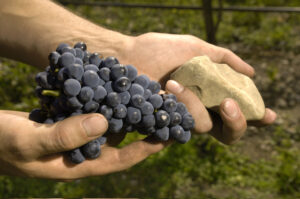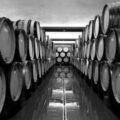Written by Julia Sevenich www.julia7ich.com
St. Laurent is the indigenous Austrian red wine grape for intellectuals. A small group of specialist Austrian winemakers have formed a “think tank” to share knowledge and experience with this rare variety explore ways to better communicate the identity of this unique regional star.
The fragrance of Bing cherry, bergamot, and juniper exudes from the deep, nearly opaque ruby red wine in my glass. Bewitching, appetizing, but certainly not the glass of Pinot Noir that I had requested. The sommelier had his hand over the label as he quickly poured and scurried off before I could make any reclamation. I was able to nab that elusive sommelier and get him to show me the bottle. He was rather ashamed and explained, “St. Laurent is almost the same as Pinot Noir.” Is it really? And must one be ashamed that St. Laurent isn’t Pinot Noir? I would have liked to have seen more interest in this variety at this award-winning Viennese restaurant at the Prater. Out of solidarity to St. Laurent, I did not exchange it for the Pinot Noir. It was delicious!
St. Laurent is a very rare grape variety that while cultivated in every wine-growing are of Austria, is nowhere the predominant grape. Vintner Gerhard Pittnauer from Gols on the east side of Lake Neusiedl says, “There are a few specialist producers scattered throughout the country that are passionately dedicated to the variety and have a long track record of producing high qualities. This high quality and the variation in styles appear to be a question not only of terroir, but of the vintner’s desire to express this. I think that the most important requirements for a good St. Laurent are talent, idealism, and passion.” The number of passionate and talented red wine vintners in Austria is growing and the vineyard area of St. Laurent has doubled since 1999.
A fussy diva
Hannes Reinisch and his two brothers cultivate quite a respectable share of the total vineyard area of St. Laurent in the Thermenregion at their Johannishof estate. He explains, “St. Laurent is very demanding. It is very sensitive during flowering and susceptible to millerandage. It ripens early and is susceptible to sunburn and botrytis. In addition to this the correct soil and the age of the vines play a significant role if you aspire to make a truly great wine.” A few of the vintners report that the variety is also prone to faults caused by volatile acids and brettanomyces. But just as a fussy diva can become the darling of a leading film director, so it is that a few talented vintners have endured the trials and tribulations on their way to discovering the passion and joy of exquisite St. Laurent. Hannes Reinisch says, “St. Laurent is one of the most fascinating and valuable red wine varieties because it is capable of uniting the power and spice that one would expect of the Rhone Valley paired with the elegance and delicacy of Burgundy. These attributes in combination with the climatic and geological preconditions in Austria result in unique, elegant and inimitable wines that demonstrate all the virtues of the variety and terroir.”
And just like a diva, St. Laurent has a rather obscure history that is woven with myths and rumours. Its name has been changed several times, possibly to give it a little more international flair. A relationship to Pinot Noir has always been suspected due to great morphological similarities. Despite this resemblance we have known for quite some time that St. Laurent possesses certain anthocyanins (responsible for colour in red wine) that are not present in the Pinot family.
Genealogy
The famous ampelographs Viala and Vermorel called this variety “Pinot St. Laurent” in their comprehensive work “Traité Général de Viticulture” (1901) and named Alsace as its likely origin. They report how the variety was exported from there to Germany where it was further spread. St. Laurent continues to be found predominantly in German-speaking Europe with just under 700 ha in Germany and 800 ha in Austria.
Despite the modern possibilities of genetic sequencing, the ancestry of St. Laurent remains unclear. Dr. Ferdinand Regner from the Federal Office and College of Wine and Horticulture Klosterneuburg explains, “An origin stemming from a Pinot crossing appears logical and explains the similarities to Pinot Noir. Despite that we find no traces of the other parent. There are genetic attributes that we have not yet found in another grape variety. If the second parent still exists, it would be easy to identify because it has left very clear traces in St. Laurent.”
A passionate history
The Klosterneuburg Monastery plays a significant historic role in the cultivation of St. Laurent. “St. Laurenz-Traube” was planted in the experimental vineyards of the monastery when it founded the world’s first viticultural school in 1863. August Wilhelm Freiherr von Babo initiated the cultivation and propagation of this variety. The most vigorous clones were then planted in the monastery’s Jungherrn vineyard in Kahlenbergerdorf in Vienna in 1893. Continued clone selection and research is practiced today by the vintner Pepi Umathum in his Frauenkirchen vineyards near Lake Neusiedl in cooperation with the research team at Klosterneuburg. Umathum places great value on genetic diversification and the ability of vines to adapt to their environment. He says, “Sankt Laurent is the desire for something new, something different in wine, a desire that leads us back to the familiar flavours of history.”
Unique terroir
Experience and observation of the variety led to prolific planting of the variety in the meagre limestone gravel of Tattendorf in 1956. The initial 5 ha of St. Laurent grew to 40 making the “Stiftsbreite” vineyard the largest contingent vineyard area planted to the variety. “The reasons for the growing vineyard area of St. Laurent in the Thermenregion are well-founded,” “The dry, alluvial limestone soils of our region are perfect for the variety. The exchange of warm Pannonian climate influence from the east with the cool wind from the Viennese forest to the north provide optimal aeration after precipitation. Decisive for the unique Tattendorf character is the long ripening period in autumn when great diurnal temperature variations are experienced. St. Laurent is a variety that does not stand out with muscle and power, but with finesse, elegance, and balance.”
Stift Klosterneuburg is not only the source of many St. Laurent vines planted throughout the country, the monastery has also once again become a role model for high-quality St. Laurent wines. Dr. Wolfgang Hamm, managing director of the Stift Klosterneuburg Winery, “I love St. Laurent because it demands our ultimate sensitivity and is capable of rewarding us with transcendental harmony.” He grounds the extraordinary quality of the St. Laurent Grosse Reserve in the rigorous selection of fruit and restriction to production in only the best red wine vintages. He expounds further, “only free run juice from fruit sourced from old vine is used for this wine. It spends four weeks on the skins, is fermented in open vats and manual punch-down of the cap is practiced. The Grosse Reserve matures for 24 months in mostly new small oak barrels.” This wine has thus far only been produced in 2000, 2003, 2006, and 2009. The superb 2011 vintage could likely bring the next.
Timeless classic or avant-garde?
Geog Stiegelmar of the Juris Estate in Gols set the standards for high-quality St. Laurent more than two decades ago when only few Austrian vintners were producing red wines of international repute. He was the first to practice malolactic fermentation in small oak barrels with the variety. The Juris St. Laurent from 1983 is elegant proof of the greatness and longevity of St. Laurent. The vintner also created the outstanding St. Georg, a blend of St. Laurent with Pinot Noir. This continues to be one of the few Austrian blends made predominantly from St. Laurent. Georg’s son Axel and his wife Herta took over the family estate in 1995 and have further developed the cultivation of St. Laurent. “This extremely difficult and fussy variety demands absolute dedication in the vineyard. To achieve truly fine, ripe tannins, we cut away half of each bunch shortly after flowering. The Goldberg vineyard in Gols has a northeast aspect and cool, dry gravel and sand soils which yield small berried St. Laurent grapes with thick skins.”
While Juris has long been established as a classic producer of St. Laurent, Brigitte and Gerhard Pittnauer, also in Gols, are considered to lead the avant-garde. Their passion for St. Laurent takes up 35% of their estate vineyard area. They have established a terroir study of this variety and produce three single vineyard examples. The Mediterranean fragrances of the Rosenberg make it reminiscent of the northern Rhône. The Altenberg has a cooler, more Pinot-like character with silky texture and wild forest berry aroma as well as a long mineral spine. The top St. Laurent is sourced from old vines that were planted in 1965. To further enhance the uniqueness of their wines, the Pittnauers practice certified organic viticulture and spontaneous fermentation. They prefer larger and less new oak, even for their top wines.
Sensuality and depth
One also finds several dedicated vintners on the west side of Lake Neusiedl in the hills of Rust and on the slopes of the Leitha Mountains. Calcareous soils and slopes that are exposed to the warmth of the sun and cool evening breezes are the preferred locations for the fussy St. Laurent vines. Hannes Schuster vinifies his wines in multiple mini charges to allow each plot its own ideal development. “I am convinced if you allow St. Laurent to do so, it possesses the ability to transport soil and origin,” says Schuster who is certainly is not a man to blow his own horn. He doesn’t need to. His St. Laurent speaks loud and clearly for the extraordinary potential of the Zagersdorf terroir and his ability to make truly classy wines. This wine was recently awarded the best rating possible by wein.pur magazine. His St. Laurent wines are uncompromisingly mineral and express discreet sensuality and depth of character.
Zweigelt and Blaufränkisch have always played a much more prolific role in Austrian red wine cultivation. Perhaps that is why St. Laurent has been spared the trends and fashions that those varieties have gone through over the last two decades. It has always been quite an authentic regional representative. There have always been excellent examples father north in Lower Austria in areas that are more famed for their Grüner Veltliner. One such example is Schloss Gobelsburg who has recently been awarded as Falstaff champion for the variety. Winemaker Michael Moosbrugger likes to describe St. Laurent to the uninitiated as “the Austrian answer to Syrah – spicy and pepper in aroma, but paired with the elegance and finesse of its mother vine Pinot Noir.”
Due to its high demands in the vineyard and its fussiness in the cellar, the production of truly great St. Laurent is never an accident, but a question of ambition and patience. Another highly recommendable producer in Lower Austria’s Carnuntum region, Philipp Grassl says, “Making St. Laurent is always thrilling. Decisive is to harvest the fragile, assumedly early-ripening grape very late. Only then does St. Laurent achieve depth and stature with balanced freshness.” The St. Laurent Think Tank meets regularly to discuss the secrets of this variety and share ways of how to make it even better.







5 Comments
@jimofayr Oh? This grape here http://t.co/U2oJUs05Zj how’s the hunt going? cc: @delectable
Austria’s Sankt Laurent is one of the world’s best red wines. That is the truth. Find it and drink it whenever you can!!
i was in austria in 2oo7 and thought St laurent was one of the best red wines i have ever enjoyed,but I cannot seem to be able to get it in this country. Are there any exporters who handle it for shipment? Please advise. tyhank you
Hi John
The best place to find these wines is by looking at Winesearcher.com